陕西汉中所处的秦巴山区猕猴桃种质资源丰富[1],依托自然气候环境的独特优势,在陕西省“东扩南移”战略实施的推动下,汉中发展猕猴桃的积极性空前高涨,截至2023 年,全市猕猴桃栽培面积0.8万hm2,但种植区土壤以黄褐土、水稻土为主,土壤有机质含量低、土壤黏重,土层板结,通透性差,果园生态环境脆弱,经济效益不高等问题普遍存在[2]。大多数果园目前采用的仍然是清耕模式,还有部分果园处于土壤裸露或杂草丛生等放任管理状态[3],这些土壤管理方式不仅造成资源浪费和生态环境破坏,而且难以提高果品产量和质量[4]。为此,汉中果园逐步采用绿肥种植、绿肥还田的管理模式来解决此类问题。
果园种植绿肥是中国重要的土壤管理方式之一[5],绿肥作为清洁有机肥源,翻压还田是绿肥利用的重要途径,通过腐解释放营养物质,促进作物养分供应,保障作物稳产、高产[6],对改良土壤、平衡农田生态系统及养分循环具有积极作用[7]。关于绿肥腐解特征和养分释放规律已有大量报道,董浩等[8]发现华北地区果园翻压二月兰、黑麦草、毛苕子还田110 d 时累积腐解率为69.1%~76.1%,呈现前期快、后期慢,最后逐渐平稳的趋势。唐红琴等[9]发现橘园翻压拉巴豆、紫云英、光叶苕子、紫花苜蓿和黑麦草5 种绿肥还田100 d 时累积腐解率为44.7%~84.3%,养分累积释放率表现为钾>氮>碳≈磷。绿肥还田时投入土壤中物料的C/N是调控有机物腐解速率和养分释放速率的关键因素[10]。绿肥还田为土壤微生物的活动提供了碳源、氮源以及能量等必需的养分,可以提高土壤有机质含量和微生物活性、改善土壤结构并促进农田生态系统的养分循环[11-12],但其养分释放过程也因气候、品种、地域、还田方式等不同而存在差异。植株养分吸收积累数量反映了绿肥营养价值的高低,不同绿肥品种的养分吸收积累存在差异,生物量大、养分含量高、养分积累量大的绿肥翻压还田后为土壤补充的养分更多,培肥土壤效果更好[13]。因此探究不同品种绿肥腐解过程和养分释放规律对充分发挥绿肥营养价值及合理高效利用绿肥具有重要意义。目前有关陕西秦巴山区猕猴桃园绿肥腐解养分释放规律的研究较少。因此,笔者在本研究中通过采用田间原位埋袋法,研究紫云英、毛苕子、箭舌豌豆、黑麦草4 种绿肥在陕西汉中猕猴桃果园的腐解过程,分析绿肥腐解干物质量及养分释放规律,旨在为汉中地区猕猴桃果园绿肥种植和高效利用提供技术参考和理论依据。
1 材料和方法
1.1 试验地概况
试验于2022—2023年在陕果集团勉县分公司猕猴桃示范基地(北纬33°15′29″N,东经106°74′31″E)进行,该地属亚热带湿润季风气候,海拔2 602.2 m,年平均气温14.3 ℃,年降水量843.9 mm,极端最高气温37.9 ℃,极端最低气温-8.4 ℃,≥10 ℃有效积温4415 ℃。供试土壤类型为黄褐土,壤质黏土,绿肥翻压前土壤理化性状为pH 4.58,有机碳含量(w,后同)5.78 g·kg-1,全氮含量1.23 g·kg-1,全磷含量0.87 g·kg-1,全钾含量12.35 g·kg-1,速效磷含量24.16 mg·kg-1,速效钾含量53.92 mg·kg-1。猕猴桃果树起垄浅栽,株距3 m,行距4 m。
1.2 试验设计
供试绿肥品种有:(1)紫云英;(2)毛苕子;(3)黑麦草;(4)箭舌豌豆。于盛花期取绿肥鲜样剪成3~5 cm 小段,按翻压量22 500 kg·hm-2计算绿肥用量,即绿肥鲜草180 g·袋-1,装入尼龙网袋(长40 cm,宽20 cm)进行田间原位腐解试验。尼龙网袋埋设深度为10 cm,埋设的尼龙网距离猕猴桃树干50 cm,水平放置且无重叠,埋设间隔为20 cm,覆土时尽量不破坏原来的土体结构,覆土与地面齐平。在猕猴桃行间埋袋,每个绿肥品种埋袋24 个,每次取3 个重复,田间埋袋示意图如图1所示。

图1 猕猴桃果园绿肥埋袋示意图
Fig.1 Schematic diagram of green manure bag burial in kiwifruit orchard
1.3 测定项目与方法
2023年4月26日开始埋设,依次在埋设后5月5日(10 d)、5月12日(17 d)、5月19日(24 d)、6月5日(41 d)、6 月26 日(62 d)、7 月17 日(83 d)、8 月21 日(118 d)、9 月14 日(142 d)取绿肥样品,去除样品表面杂物及浮土,拆开尼龙网袋洗净样品,样品于烘箱65 ℃烘干后测定绿肥样品干质量(g),粉碎后测定N、P2O5、K2O 及C 含量。植株样品采用H2SO4-H2O2消煮[14],全氮含量采用连续流动分析仪(AA3)测定,全磷含量采用钒钼黄比色法测定,全钾含量采用火焰光度法测定,全碳含量用重铬酸钾容量法-外加热法测定。
1.4 相关指标计算方法
干物质量/(kg·hm-2)=干质量/S×10,S为尼龙网袋面积,10为换算系数;
干物质腐解量/(kg·hm-2)=初始干物质量—i d的干物质量,i为腐解天数;
累积腐解率/%=干物质腐解量/初始干物质量×100;
干物质腐解速率/(kg·hm-2·d-1)=单位时间内干物质腐解量/单位时间;
养分腐解量/(kg·hm-2)=初始养分量—i d 的养分量,i为腐解天数;
养分累积腐解率/%=养分腐解量/初始养分量×100;
养分腐解速率/(kg·hm-2·d-1)=单位时间内养分腐解量/单位时间。
1.5 数据处理
应用Excel 2010进行数据整理,采用SAS 8.1进行单因素方差分析和显著性检验,采用Origin 2017绘图。
2 结果与分析
2.1 不同绿肥干物质量及腐解变化特征
猕猴桃园4 种绿肥干物质量腐解表现为:先快速腐解(4 月26 日至5 月19 日),再中速腐解(5 月20 日至6 月5 日),最后缓慢腐解(6 月6 日至9 月14日)。0~24 d 为快速腐解期,25~41 d 为中速腐解期,42~142 d 为缓慢腐解期。黑麦草、箭舌豌豆、毛苕子、紫云英4 个品种绿肥初始干物质量为黑麦草(7 070.00 kg·hm-2)>箭舌豌豆(6 623.33 kg·hm-2)>毛苕子(5 337.22 kg·hm-2)>紫云英(4 298.89 kg·hm-2)(图2-A),翻压24 d 时累积干物质腐解量分别为4 561.67、4 310.55、3 618.89、2 000.56 kg·hm-2,腐解率分别为64.52%、65.08%、67.80%、46.54%(图2-A);腐解速率为262.86、194.84、178.73、41.51 kg·hm-2·d-1(图2-B);翻压142 d时累积腐解量分别为6 519.44、5 647.48、4 676.11、3 395.56 kg·hm-2,累积腐解率分别为92.21%、85.27%、87.61%、78.99%。翻压24 d和142 d 黑麦草累积腐解干物质量、腐解率均最高,翻压24 d时毛苕子腐解率最高。
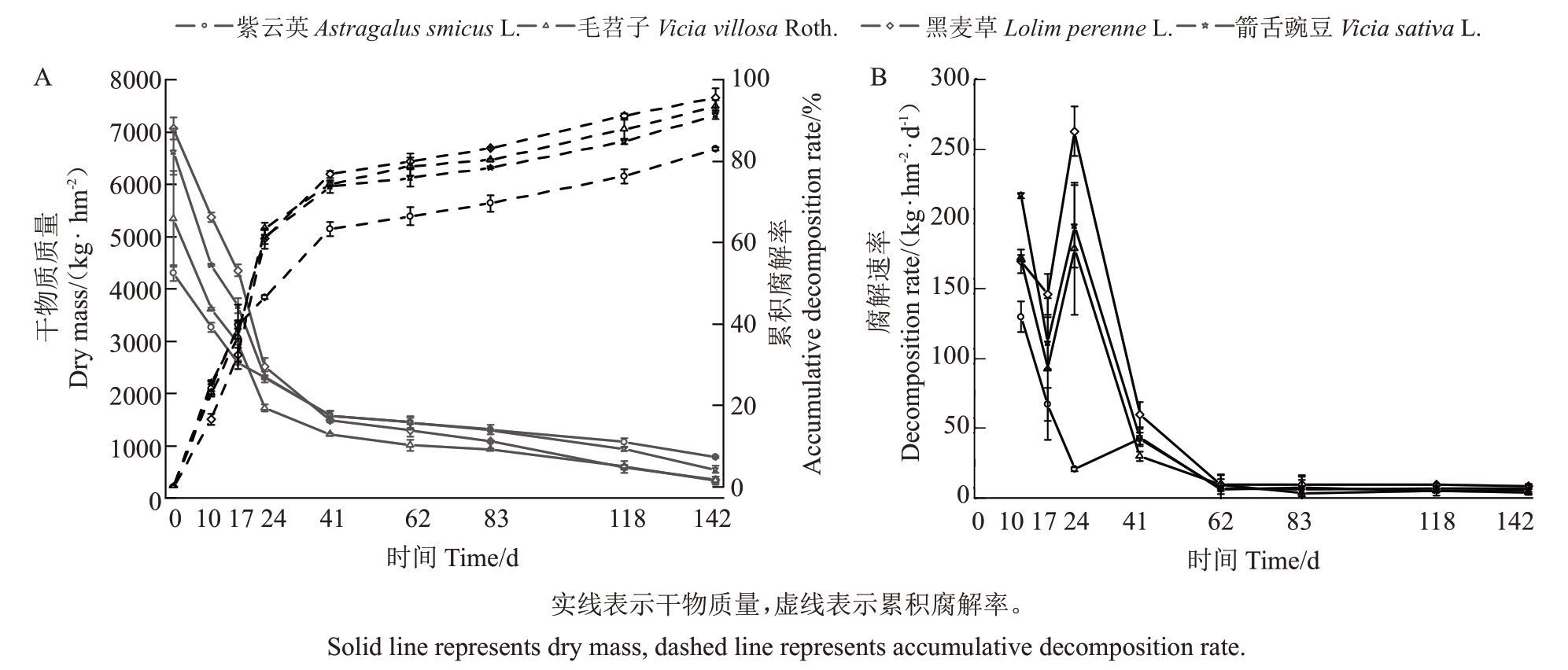
图2 猕猴桃园不同绿肥品种干物质量腐解特征
Fig.2 Characteristics of dry weight release from different green manures in kiwifruit orchard
2.2 不同绿肥碳养分释放特征
黑麦草、箭舌豌豆、毛苕子、紫云英4 个品种绿肥初始碳累积量为箭舌豌豆(3 238.07 kg·hm-2)>黑麦草(3 220.29 kg·hm-2)>毛苕子(2 490.59 kg·hm-2)>紫云英(1 806.33 kg·hm-2)(图3-A),翻压24 d时碳累积量分别为2 123.48、2 397.43、1 641.03、771.37 kg·hm-2,碳累积腐解率分别为65.94%、74.04%、65.89%、42.70%(图3-A);碳腐解速率为93.72、99.21、145.60、14.63 kg·hm-2·d-1(图3-B);翻压142 d时碳累积腐解率分别为93.63%、93.37%、91.48%、74.45%,累积腐解质量分别为3 015.28、2 855.65、2 278.46、1 344.88 kg·hm-2。翻压24 d箭舌豌豆碳累积量、碳累积腐解率均最高,毛苕子碳腐解速率最大;翻压142 d时黑麦草腐解率、碳累积量、碳累积腐解率均最高。
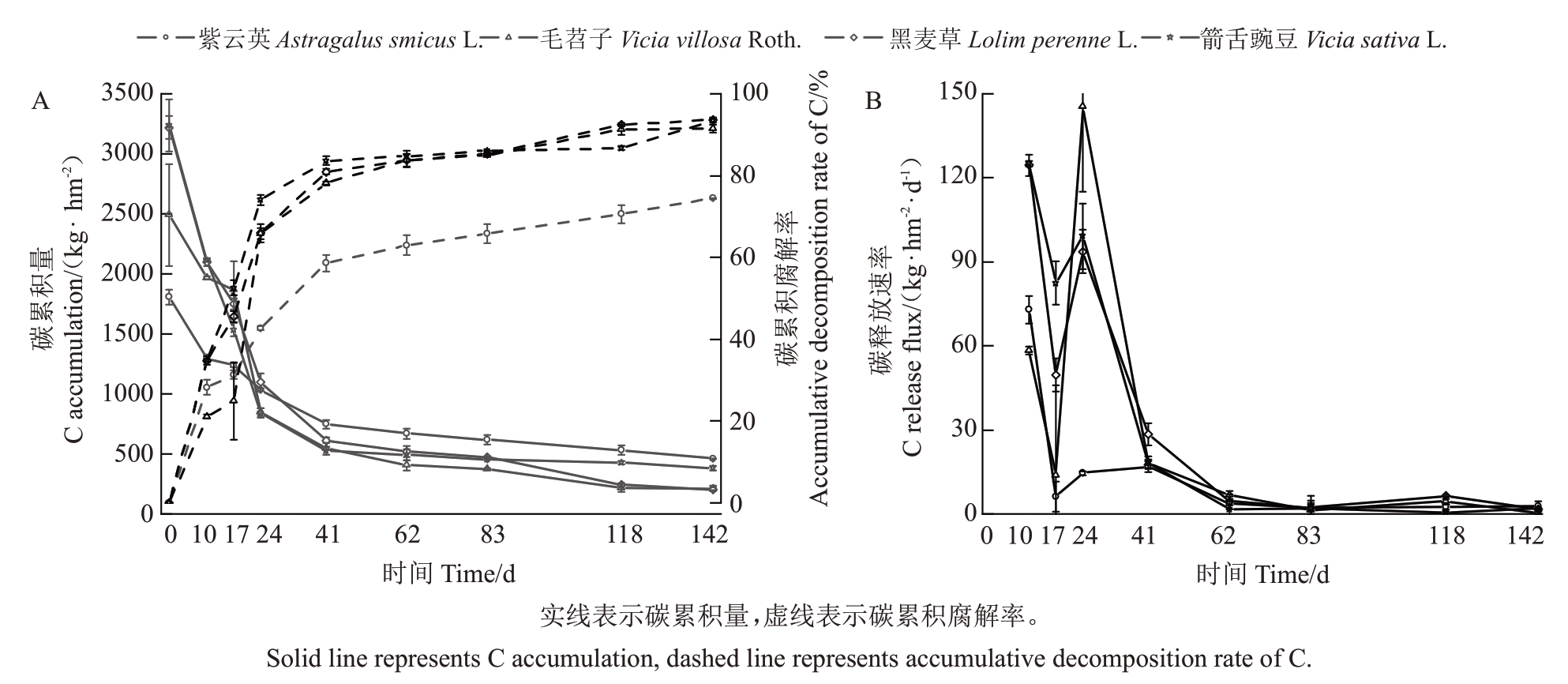
图3 猕猴桃园不同绿肥品种碳释放特征
Fig.3 Characteristics of C release from different green manures in kiwifruit orchard
2.3 不同绿肥氮养分释放特征
黑麦草、箭舌豌豆、毛苕子、紫云英4 个品种绿肥初始氮累积量为毛苕子(215.57 kg·hm-2)>黑麦草(207.34 kg·hm-2)>箭舌豌豆(148.47 kg·hm-2)>紫云英(114.99 kg·hm-2)(图4-A),翻压24 d 时氮累积量分别为147.45、102.83、172.22、62.56 kg·hm-2,氮素累积腐解率分别为69.26%、71.11%、79.89%、54.40%(图4-A);氮腐解速率分别为2.30、4.00、3.73、0.93 kg·hm-2·d-1(图4-B);翻压142 d时氮素累积腐解率分别为89.16%、83.67%、89.85%、69.11%,累积氮腐解量分别为132.38、173.49、193.70、79.47 kg·hm-2。翻压24、41和142 d毛苕子氮累积量、氮素累积腐解率均最高。

图4 猕猴桃园不同绿肥品种氮释放特征
Fig.4 Characteristics of N release from different green manures in kiwifruit orchard
2.4 不同绿肥磷养分释放特征
黑麦草、箭舌豌豆、毛苕子、紫云英4 个品种绿肥初始磷累积量为黑麦草(25.61 kg·hm-2)>箭舌豌豆(23.14 kg·hm-2)>毛苕子(22.38 kg·hm-2)>紫云英(8.60 kg·hm-2)(图5-A),翻压24 d 时磷累积量分别为10.89、7.19、7.19、1.59 kg·hm-2,磷素累积腐解率分别为42.53%、31.10%、32.13%、18.50%(图5-A);磷腐解速率分别为0.66、0.78、0.11、0.06 kg·hm-2·d-1(图5-B);翻压142 d时磷素累积腐解率分别为92.65%、73.88%、82.47%、59.60%,累积磷腐解量分别为23.72、17.09、18.46、5.12 kg·hm-2。翻压24 d和142 d黑麦草磷累积量、磷素累积腐解率均最高。

图5 猕猴桃园不同绿肥品种磷释放特征
Fig.5 Characteristics of P2O5 release from different green manures in kiwifruit orchard
2.5 不同绿肥钾养分释放特征
黑麦草、箭舌豌豆、毛苕子、紫云英4 个品种绿肥初始钾累积量为黑麦草(276.52 kg·hm-2)>箭舌豌豆(158.65 kg·hm-2)>毛苕子(111.19 kg·hm-2)>紫云英(86.40 kg·hm-2)(图6-A),翻压24 d时钾累积量分别为241.86、145.74、101.40、78.17 kg·hm-2,钾素累积腐解率分别为87.46%、91.86%、91.19%、90.48%(图6-A);钾腐解速率分别为6.67、3.22、1.96、1.58 kg·hm-2·d-1(图6-B);翻压142 d时钾素累积腐解率分别为99.28%、98.72%、98.53%、97.81%,累积钾腐解量分别为274.54、156.61、109.56、84.50 kg·hm-2。翻压24 d黑麦草钾累积量最高;翻压24 d箭舌豌豆钾素累积腐解率最高,且除黑麦草外,其他品种钾素累积腐解率均在90%以上;翻压142 d 黑麦草钾累积量、钾素累积腐解率均最高。
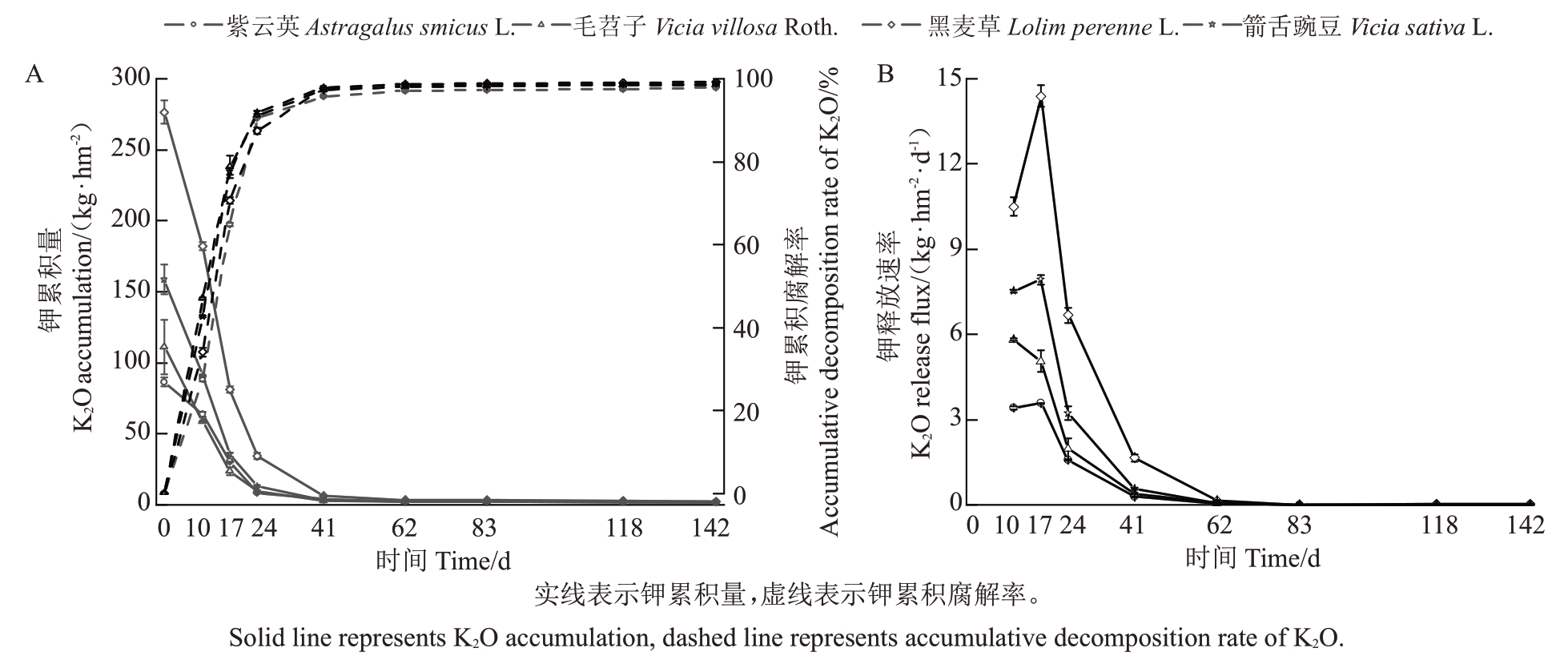
图6 猕猴桃园不同绿肥品种钾释放特征
Fig.6 Characteristics of K2O release from different green manures in kiwifruit orchard
2.6 不同绿肥碳氮比养分释放特征
黑麦草、箭舌豌豆、毛苕子、紫云英4 个品种绿肥碳氮比呈先快速上升后下降至缓慢平稳(图7),除紫云英外,黑麦草、箭舌豌豆、毛苕子3 种绿肥碳氮比均在翻压17 d 达到峰值,其碳氮比分别为28.40、17.47、26.89,经过142 d腐解,4种绿肥碳氮比表现为紫云英>黑麦草>箭舌豌豆>毛苕子,分别为12.99、12.74、11.30、9.70。
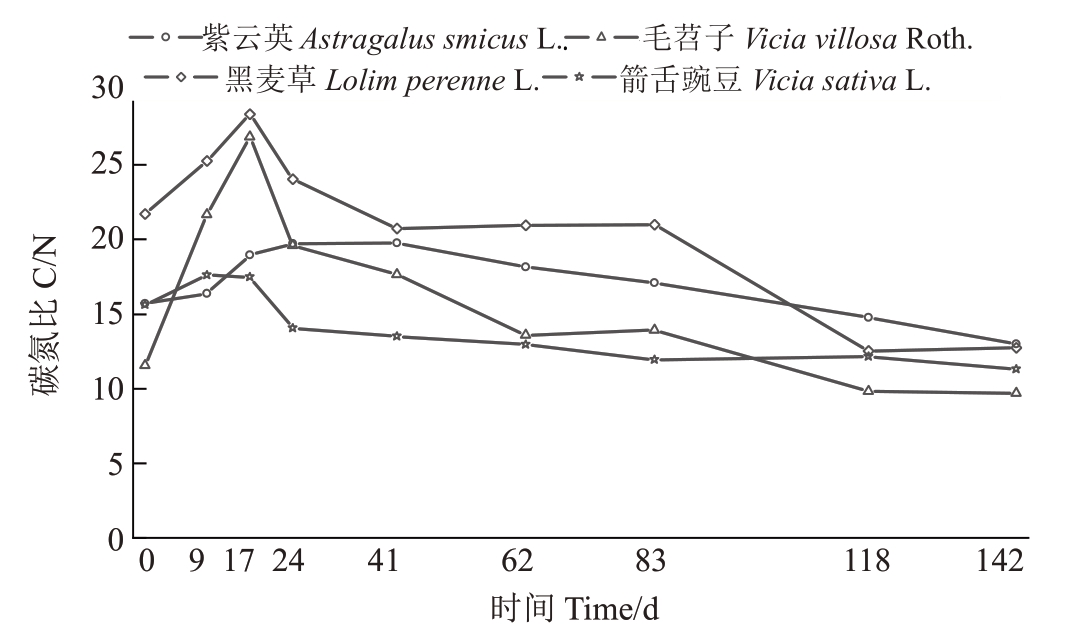
图7 猕猴桃园不同绿肥品种碳氮比释放特征
Fig.7 Characteristics of C/N different green manures in kiwifruit orchard
2.7 绿肥腐解特征相关性分析
相关性分析显示(图8),绿肥碳氮比与干物质量、腐解速率和碳、氮、磷、钾释放速率及碳、磷、钾累积量均呈显著正相关(p<0.05),与碳、磷累积释放率均呈显著负相关(p<0.05)。
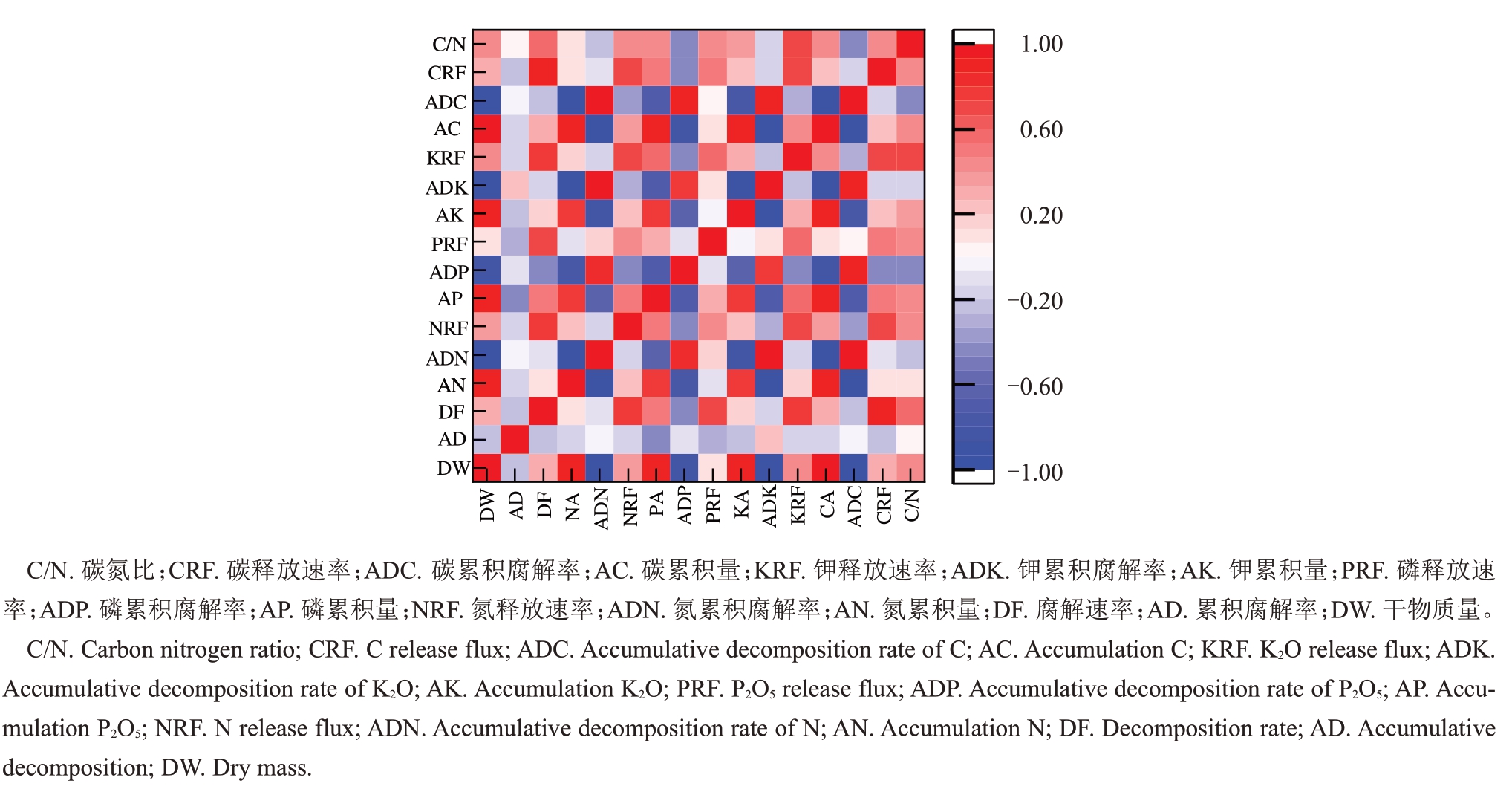
图8 绿肥腐解特征相关性分析
Fig.8 Correlation analysis of decomposition characteristics of green manure
3 讨 论
绿肥腐解和养分释放受绿肥品种、土壤温湿度及微生物等多种因素的影响[10]。猕猴桃果园绿肥腐解一般分为快速(0~12 d)、中速(12~50 d)、缓慢分解期(50 d 后)3 个阶段[15]。在本研究中,4 种绿肥腐解分为快速腐解期(0~24 d)、中速腐解期(25~41 d)和缓慢腐解期(42~142 d)。绿肥干物质量减少量和腐解速率均存在先快后慢的规律,且翻压后24 d内腐解速率较高,这与洪莉等[16]研究结果相一致。腐解前24 d,绿肥植株体内大量水溶性有机物随水分运动快速流失,干物质量快速减少,同时这些水溶性有机物为微生物的活动提供能源和养分,增加微生物数量和提高活性,也促进了绿肥腐解[17],此时期4种绿肥干物质减少量为2 000.56~4 561.67 kg·hm-2,腐解率为46.54%~67.80%。腐解中期(25~41 d)由于土壤性状变好,微生物活性提高促进绿肥腐解[17],此时期4种绿肥干物质减少量为2 720.00~5 574.44 kg·hm-2,腐解率为46.54%~67.80%。腐解后期(42~142 d)绿肥残体中主要成分为难分解组分,腐解速率和养分释放速率逐渐降低[18],此时期4 种绿肥干物质减少量为3 395.56~6 519.44 kg·hm-2,累积腐解率为78.99%~92.21%。因此绿肥腐解呈现前期快、中后期慢的规律[19]。张义宁等[20]发现在旱作玉米地,豆科绿肥腐解率高于禾本科绿肥,在本研究中,绿肥品种间干物质量减少量表现为黑麦草>箭舌豌豆>毛苕子>紫云英,腐解率表现为黑麦草>毛苕子>箭舌豌豆>紫云英,表现为禾本科绿肥腐解高于豆科绿肥,产生这种差异的原因可能是绿肥腐解受温度、降雨、碳氮比[21]、绿肥组分和组织结构[22]等多种因素的综合影响,但不同绿肥间腐解率不同的具体原因还需进一步探究。
猕猴桃园翻压4种绿肥还田养分释放率表现为钾>碳>氮>磷,平均累积释放率分别为98.58%、88.23%、82.95%、77.15%,这与高帆等[23]研究结果一致。绿肥还田后养分释放速率受在绿肥体内存在形态和分布位置的影响[24]。何万荣等[25]发现枣园翻压白三叶、油菜和毛苕子3 种绿肥,碳、氮养分在前21 d 快速释放,释放率均在60%以上。氮素大部分以蛋白质和氨基酸形式,少量以硝铵态氮形式存在于植株体内。在本研究中,碳、氮养分均在前24 d快速腐解,平均腐解率为62.14%、68.66%。钾素以离子形态存在极易被释放,绿肥腐解前24 d 除黑麦草外,其他3 种豆科绿肥钾释放率均在91%以上。磷素主要以难分解的有机态存在,释放过程较慢,4种绿肥腐解前24 d 磷平均释放率为31.06%。绿肥翻压腐解前24 d 正处于猕猴桃萌芽展叶—开花坐果期,属猕猴桃迅速生长期,此时期充足的营养元素供应是保证果实生长发育和品质形成的关键[26]。绿肥腐解前24 d产生的碳、氮、钾、磷释放量平均为1 733.33、121.26、141.79、6.71 kg·hm-2。绿肥品种不同,其养分含量也各不相同。各品种绿肥植株养分含量表现为碳>钾>氮>磷,其中黑麦草碳、钾、磷释放量最高,毛苕子氮释放量最高,紫云英各营养元素均最低。绿肥还田时投入土壤中物料的C/N是调控有机物腐解速率和养分释放速率的关键因素[10],黑麦草中碳的比例高于豆科绿肥[27],其C/N 存在差异,因此其腐解率和碳释放率的变化趋势不一致。本研究中绿肥C/N 与碳、磷累积释放率均呈显著负相关,碳氮比越小,越有利于绿肥腐解,各品种绿肥碳氮比先升高后降低,这与前人研究结果相一致[24]。黑麦草翻压还田后碳氮比最高,腐解142 d毛苕子碳氮比最低。绿肥腐解过程产生大量可溶性有机物,将自身养分转移到土壤中,对土壤环境具有很好的改善,利于猕猴桃根系生长和养分吸收[28]。绿肥还田可以提升土壤养分的有效性和持久性,保障了猕猴桃生育中后期养分的持续供应。
陕南汉中地区猕猴桃果园土壤黏重、通透性差,养分难以释放,不利于果树生长发育[29]。研究发现,果园种植绿肥可以改善土壤理化性质,减少养分流失,还可以增强树势,改善树体营养状况,进而提高果实产量和品质[30-32]。汉中猕猴桃新梢生长高峰有两个时期,分别为4 月中旬至6 月上旬和8 月,果实迅速生长期为5 月上旬至6 月中旬。猕猴桃从早春萌芽到新梢生长需要大量氮肥,为枝、叶、花、果实充分发育的物质基础;在6月开花后对磷的需求增加,此时期正处于绿肥快速腐解期和中速腐解期,为果园提供足量的氮素和磷素,8 月份猕猴桃在果实膨大期对钾素的需求直线上升,果树生长发育需要连续不断地从外界吸收养分,以满足生命活动的需要,但各生育期需要的营养成分却有所差异[33]。因此根据绿肥腐解规律和养分释放特征,结合生育期搭配肥料合理施用可以为果树生长发育提供充足的养分来源。猕猴桃果园种植利用绿肥最终要与农业生产实际相结合,本试验于4 月中下旬统一刈割绿肥鲜草翻压还田,而实际生产中绿肥品种不同,其生育期也存在差异,绿肥翻压还田时间必然也存在差异,因此有必要针对不同绿肥品种选择适宜的翻压还田时间。笔者在本研究中只有一年的观测结果,缺乏不同绿肥翻压还田对猕猴桃生长发育等方面影响的研究,因此下一步有必要开展不同年份间绿肥翻压还田效果及对猕猴桃果树生长发育影响方面的研究,对猕猴桃果园多年种植绿肥的研究结果进行综合评价。
4 结 论
猕猴桃园种植绿肥翻压还田腐解分快速腐解期(0~24 d)、中速腐解期(25~41 d)和缓慢腐解期(42~142 d)3 个阶段。腐解前24 d,碳、氮腐解率均在62%以上,钾腐解率在87%以上,磷腐解率在18%以上。腐解142 d后,黑麦草、箭舌豌豆、毛苕子、紫云英腐解率分别为93.63%、93.37%、91.48%、74.45%。4 种绿肥养分释放率表现为钾>碳>氮>磷,黑麦草钾、磷释放量最高,毛苕子氮释放量最高,箭舌豌豆碳释放量最高。综上,黑麦草、毛苕子和箭舌豌豆均适宜在汉中猕猴桃果园种植。果园种植黑麦草、毛苕子和箭舌豌豆等翻压还田可以在果树萌芽展叶期减少化学氮肥和钾肥的施用量。
[1] 刘艳飞,王中月,谢利华,张阿玲,刘占德.12 个猕猴桃栽培品种在陕西秦巴山区的引种表现[J]. 西北农业学报,2022,31(5):603-611.LIU Yanfei,WANG Zhongyue,XIE Lihua,ZHANG Aling,LIU Zhande. Introductive performance of twelve kiwifruit cultivars in Qinba mountainous area of Shaanxi province[J].Acta Agriculturae Boreali-occidentalis Sinica,2022,31(5):603-611.
[2] 王吕,秦宇航,吴玉红,淡亚彬,郝兴顺,肖飞,陈浩.猕猴桃园绿肥品种筛选和生草管理对土壤养分的影响[J].果树学报,2023,40(9):1885-1893.WANG Lü,QIN Yuhang,WU Yuhong,DAN Yabin,HAO Xingshun,XIAO Fei,CHEN Hao.Selection of green manure varieties and effects of grass management modes on soil fertility in kiwifruit orchards[J]. Journal of Fruit Science,2023,40(9):1885-1893.
[3] 左玉环,刘高远,杨莉莉,梁连友,同延安.陕西渭北柿子园种植白三叶草对土壤养分和生物学性质的影响[J].应用生态学报,2019,30(2):518-524.ZUO Yuhuan,LIU Gaoyuan,YANG Lili,LIANG Lianyou,TONG Yan’an. Effect of planting white clover on nutrients and biological properties of soils in persimmon orchard of Weibei,Shaanxi province,China[J]. Chinese Journal of Applied Ecology,2019,30(2):518-524.
[4] 李晓阳,任丽华,计保全,马晓彤.生草覆盖对山地果园土壤物理性状的影响[J].水土保持应用技术,2019(4):7-9.LI Xiaoyang,REN Lihua,JI Baoquan,MA Xiaotong. Effects of grass mulching on soil physical properties in mountain orchard[J].Technology of Soil and Water Conservation,2019(4):7-9.
[5] 杨旺,赵劲飞,刘新英,廖结安,席琳乔,王贞元,冶瑞,陈云生.果园行间绿肥粉碎旋耕一体机的设计与试验[J].农机化研究,2023,45(9):46-53.YANG Wang,ZHAO Jinfei,LIU Xinying,LIAO Jie’an,XI Linqiao,WANG Zhenyuan,YE Rui,CHEN Yunsheng. Design and experiment of an integrated machine for green manure crushing and rotary tillage in orchard row[J]. Journal of Agricultural Mechanization Research,2023,45(9):46-53.
[6] 张璐,黄晶,高菊生,曹卫东,高鹏,杨志长.长期绿肥与氮肥减量配施对水稻产量和土壤养分含量的影响[J].农业工程学报,2020,36(5):106-112.ZHANG Lu,HUANG Jing,GAO Jusheng,CAO Weidong,GAO Peng,YANG Zhichang. Effects of long-term green manure and reducing nitrogen applications on rice yield and soil nutrient content[J].Transactions of the Chinese Society of Agricultural Engineering,2020,36(5):106-112.
[7] 杨龙.果园生草草种腐解特征及其对土壤养分的影响[D].杨凌:西北农林科技大学,2021.YANG Long. Characteristics and effects on soil nutrients of grass species decomposition in apple orchard [D]. Yangling:Northwest A&F University,2021.
[8] 董浩,于淑慧,史桂芳,朱国梁,牟小翎,曹卫东.春季翻压3 种果园绿肥腐解及养分释放特征研究[J].中国农学通报,2021,37(6):75-81.DONG Hao,YU Shuhui,SHI Guifang,ZHU Guoliang,MU Xiaoling,CAO Weidong. The decomposition and nutrient release characteristics of three kinds of orchard green manures in spring[J].Chinese Agricultural Science Bulletin,2021,37(6):75-81.
[9] 唐红琴,李忠义,韦彩会,董文斌,曾成城,苏利荣,蒙炎成,何铁光,莫永诚,黄东.橘园绿肥覆盖还田下的腐解及养分释放动态特征[J].江苏农业科学,2022,50(7):221-227.TANG Hongqin,LI Zhongyi,WEI Caihui,DONG Wenbin,ZENG Chengcheng,SU Lirong,MENG Yancheng,HE Tieguang,MO Yongcheng,HUANG Dong. Dynamic characteristics of decomposition and nutrient release under green manure mulching in citrus orchard[J]. Jiangsu Agricultural Sciences,2022,50(7):221-227.
[10] 李增强,王建红,张贤.绿肥腐解及养分释放过程研究进展[J].中国土壤与肥料,2017(4):8-16.LI Zengqiang,WANG Jianhong,ZHANG Xian.A review on the research of decomposition and nutrients release of green manure[J].Soil and Fertilizer Sciences in China,2017(4):8-16.
[11] 崔志强,李宪利,崔天舒. 果园绿肥腐解及养分释放动态研究[J].中国农学通报,2014,30(22):121-127.CUI Zhiqiang,LI Xianli,CUI Tianshu. Study on characteristics of decomposing and nutrients releasing of green manures in orchards[J]. Chinese Agricultural Science Bulletin,2014,30(22):121-127.
[12] 姚高乾,周锋,吕小蓉,杨友琼,程易,吴伯志,安曈昕.深松耕和绿肥还田对云南坡耕地耕层土壤物理性状的影响[J].中国土壤与肥料,2021(1):220-228.YAO Gaoqian,ZHOU Feng,LÜ Xiaorong,YANG Youqiong,CHENG Yi,WU Bozhi,AN Tongxin. Effects of subsoiling tillage and green crop returning to sloping farmland on soil physical properties[J].Soil and Fertilizer Sciences in China,2021(1):220-228.
[13] 陈晓芬,陈静蕊,秦文婧,武志峰,李淑惠,刘明,徐昌旭,刘佳.红壤荒地上7 种豆科绿肥养分富集能力综合评价[J].中国草地学报,2020,42(4):153-160.CHEN Xiaofen,CHEN Jingrui,QIN Wenjing,WU Zhifeng,LI Shuhui,LIU Ming,XU Changxu,LIU Jia. Comprehensive assessment of nutrient enrichment capacity of 7 leguminous green manures on red soil wasteland[J].Chinese Journal of Grassland,2020,42(4):153-160.
[14] 鲁如坤.土壤农业化学分析方法[M].北京:中国农业科学技术出版社,2000.LU Rukun.Analytical methods for soil and agro-chemistry[M].Beijing:China Agricultural Science and Technology Press,2000.
[15] 梁军.不同绿肥还田腐解动态及其对土壤养分的影响[D].长沙:湖南农业大学,2018.LIANG Jun. Disintegration dynamics of different green manures and their effects on soil nutrients[D]. Changsha:Hunan Agricultural University,2018.
[16] 洪莉,陈令会,曹锦萍,董军,王会福.南方桃园不同绿肥的腐解及养分释放规律研究[J].江苏农业科学,2019,47(11):294-297.HONG Li,CHEN Linghui,CAO Jinping,DONG Jun,WANG Huifu.Study on characteristics of decomposing and nutrients releasing of different green manures in southern orchards[J].Jiangsu Agricultural Sciences,2019,47(11):294-297.
[17] LUPWAYI N Z,CLAYTON G W,O’DONOVAN J T,HARKER K N,TURKINGTON T K,RICE W A. Decomposition of crop residues under conventional and zero tillage[J]. Canadian Journal of Soil Science,2004,84(4):403-410.
[18] 陈宁,高玲,刘国道,张如莲,郇恒福.热带豆科绿肥腐解特性探究[J].热带作物学报,2016,37(8):1470-1475.CHEN Ning,GAO Ling,LIU Guodao,ZHANG Rulian,HUAN Hengfu. Decomposing characteristics of green manure of tropical Leguminosae plants[J]. Chinese Journal of Tropical Crops,2016,37(8):1470-1475.
[19] 邓小华,罗伟,周米良,田峰,张明发,江智敏,郑宏斌,张仲文.绿肥在湘西烟田中的腐解和养分释放动态[J].烟草科技,2015,48(6):13-18.DENG Xiaohua,LUO Wei,ZHOU Miliang,TIAN Feng,ZHANG Mingfa,JIANG Zhimin,ZHENG Hongbin,ZHANG Zhongwen. Dynamics of decomposition and nutrient release of green manures in tobacco fields in Xiangxi[J]. Tobacco Science&Technology,2015,48(6):13-18.
[20] 张义宁,王俊.绿肥腐解过程及其对旱作农田土壤碳氮和玉米产量的影响[J].生态学杂志,2023,42(11):2613-2621.ZHANG Yining,WANG Jun. Decomposition of green manures and their effects on soil carbon and nitrogen,and crop yield in a dryland spring maize field[J].Chinese Journal of Ecology,2023,42(11):2613-2621.
[21] ÁLVARO-FUENTES J,MORELL F J,MADEJÓN E,LAMPURLANÉS J,ARRÚE J L,CANTERO-MARTÍNEZ C. Soil biochemical properties in a semiarid Mediterranean agroecosystem as affected by long-term tillage and N fertilization[J]. Soil and Tillage Research,2013,129:69-74.
[22] 代文才,高明,兰木羚,黄容,王金柱,王子芳,韩晓飞.不同作物秸秆在旱地和水田中的腐解特性及养分释放规律[J].中国生态农业学报,2017,25(2):188-199.DAI Wencai,GAO Ming,LAN Muling,HUANG Rong,WANG Jinzhu,WANG Zifang,HAN Xiaofei. Nutrient release patterns and decomposition characteristics of different crop straws in drylands and paddy fields[J]. Chinese Journal of Eco-Agriculture,2017,25(2):188-199.
[23] 高帆,鞠玺凯,郭琪琳,李清华,刘庆.豌豆茎秆在土壤中的腐解与养分释放特征[J]. 青岛农业大学学报(自然科学版),2023,40(3):220-226.GAO Fan,JU Xikai,GUO Qilin,LI Qinghua,LIU Qing. Decomposition and nutrient release of pea stalks in soil[J]. Journal of Qingdao Agricultural University (Natural Science),2023,40(3):220-226.
[24] 刘佳,张杰,秦文婧,杨成春,谢杰,项兴佳,曹卫东,徐昌旭.红壤旱地毛叶苕子不同翻压量下腐解及养分释放特征[J].草业学报,2016,25(10):66-76.LIU Jia,ZHANG Jie,QIN Wenjing,YANG Chengchun,XIE Jie,XIANG Xingjia,CAO Weidong,XU Changxu. Decomposition and nutrient release characteristics of different Vicia villosa green manure applications in red soil uplands of South China[J].Acta Prataculturae Sinica,2016,25(10):66-76.
[25] 何万荣,韩路,席琳乔,王海珍.南疆枣园三种不同绿肥腐解及养分释放规律研究[J]. 干旱地区农业研究,2021,39(3):129-136.HE Wanrong,HAN Lu,XI Linqiao,WANG Haizhen. The characteristics of decomposing and nutrients releasing of three green manures in orchard in Southern Xinjiang[J]. Agricultural Research in the Arid Areas,2021,39(3):129-136.
[26] 周红伟,叶旭,安华明.贵长猕猴桃果实生长发育及矿质养分积累规律[J].山地农业生物学报,2021,40(2):67-70.ZHOU Hongwei,YE Xu,AN Huaming. Studys on the fruit growth and nutrient elements accumulation in kiwifruit of Actinidia deliciosa cv. Guichang[J]. Journal of Mountain Agriculture and Biology,2021,40(2):67-70.
[27] 杨伟,朱杰,姚涞,赵东竹,聂江文,蒋梦蝶,朱波,易丽霞,刘章勇.有机无机配施对稻田不同绿肥腐解特征和养分释放速率的影响[J/OL]. 生态学杂志,2024:1-10(2024-07-05). https://link.cnki.net/urlid/21.1148.Q.20240704.2000.004 YANG Wei,ZHU Jie,YAO Lai,ZHAO Dongzhu,NIE Jiangwen,JIANG Mengdie,ZHU Bo,YI Lixia,LIU Zhangyong. Effects of combined organic and inorganic application on decomposition characteristics and nutrient release rates of different green manures in rice fields[J/OL]. Chinese Journal of Ecology,2024:1- 10 (2024- 07- 05). https://link.cnki.net/urlid/21.1148.Q.20240704.2000.004
[28] ISLAM M M,URMI T A,RANA M S,ALAM M S,HAQUE M M. Green manuring effects on crop morpho-physiological characters,rice yield and soil properties[J]. Physiology and Molecular Biology of Plants,2019,25(1):303-312.
[29] 马一宁.猕猴桃高温热害脆弱性综合评价研究:以陕西省为研究区[D].长春:东北师范大学,2022.MA Yining.Vulnerability assessment of high temperature disaster in kiwifruit-A case study in Shaanxi province,China[D].Changchun:Northeast Normal University,2022.
[30] 王孝娣,刘凤之,史祥宾,张克坤,郑晓翠,王海波.绿肥对‘春雪’桃叶片质量及果实品质的影响[J].中国果树,2016(4):26-29.WANG Xiaodi,LIU Fengzhi,SHI Xiangbin,ZHANG Kekun,ZHENG Xiaocui,WANG Haibo.Effects of green manure on the quality of‘Chunxue’peach leaves and fruit [J]. China Fruits,2016(4):26-29.
[31] 秦景逸,张云,王秀梅,朱甜甜,刘康.绿肥间作对果园产量及经济收益的影响[J].广东农业科学,2017,44(1):43-48.QIN Jingyi,ZHANG Yun,WANG Xiumei,ZHU Tiantian,LIU Kang. Effects of intercropping green manure on yeild and economic benefits of orchard[J]. Guangdong Agricultural Sciences,2017,44(1):43-48.
[32] 田想,张威,伍玉鹏,胡荣桂,罗越,姜炎彬.绿肥种植配施减量氮肥对橘园土壤肥力及果实质量的影响[J].中国土壤与肥料,2020(6):197-204.TIAN Xiang,ZHANG Wei,WU Yupeng,HU Ronggui,LUO Yue,JIANG Yanbin. Effects of planting green manure and reduced nitrogen fertilizer application on soil fertility and fruit quality in citrus orchard[J]. Soil and Fertilizer Sciences in China,2020(6):197-204.
[33] 王建.猕猴桃树体生长发育、养分吸收利用与累积规律[D].杨凌:西北农林科技大学,2008.WANG Jian. The growth,nutrients uptake,utilization and accumulation in‘Qin Mei’kiwifruit tree[D]. Yangling:Northwest A&F University,2008.